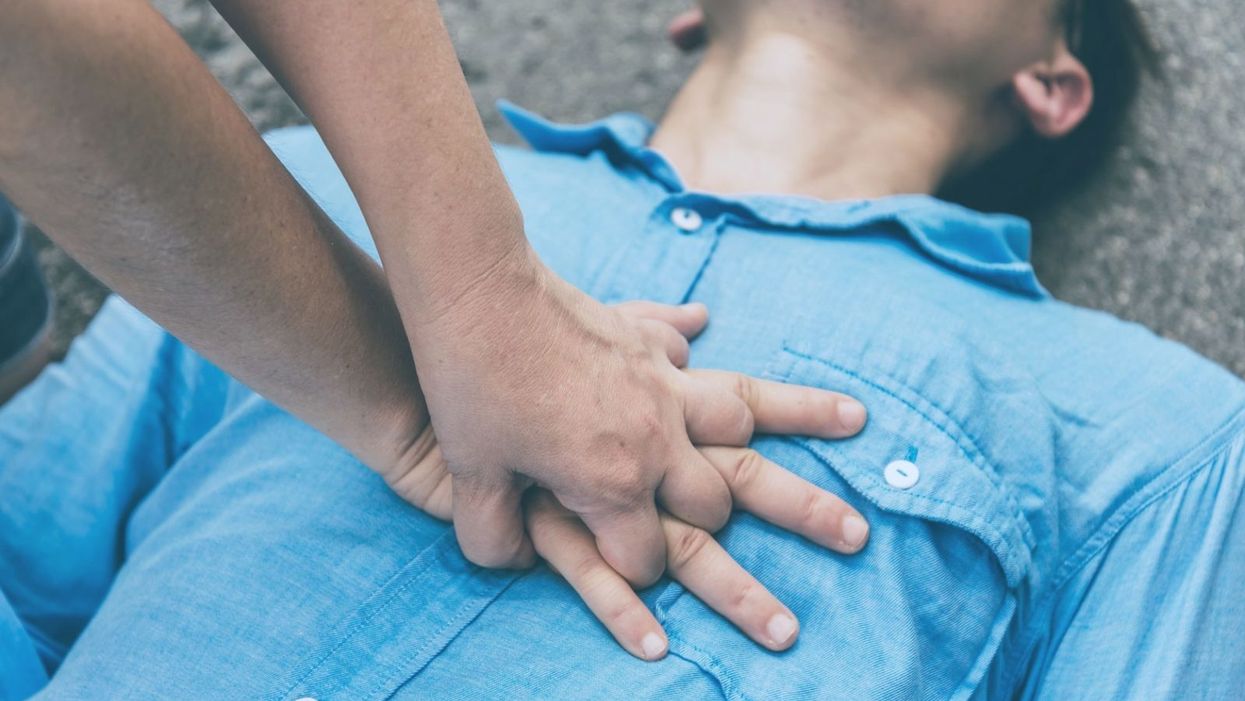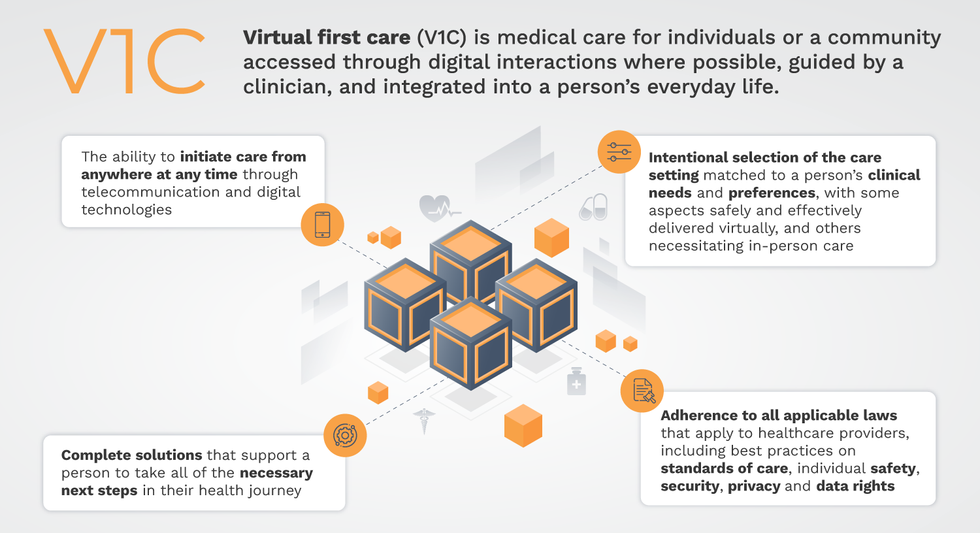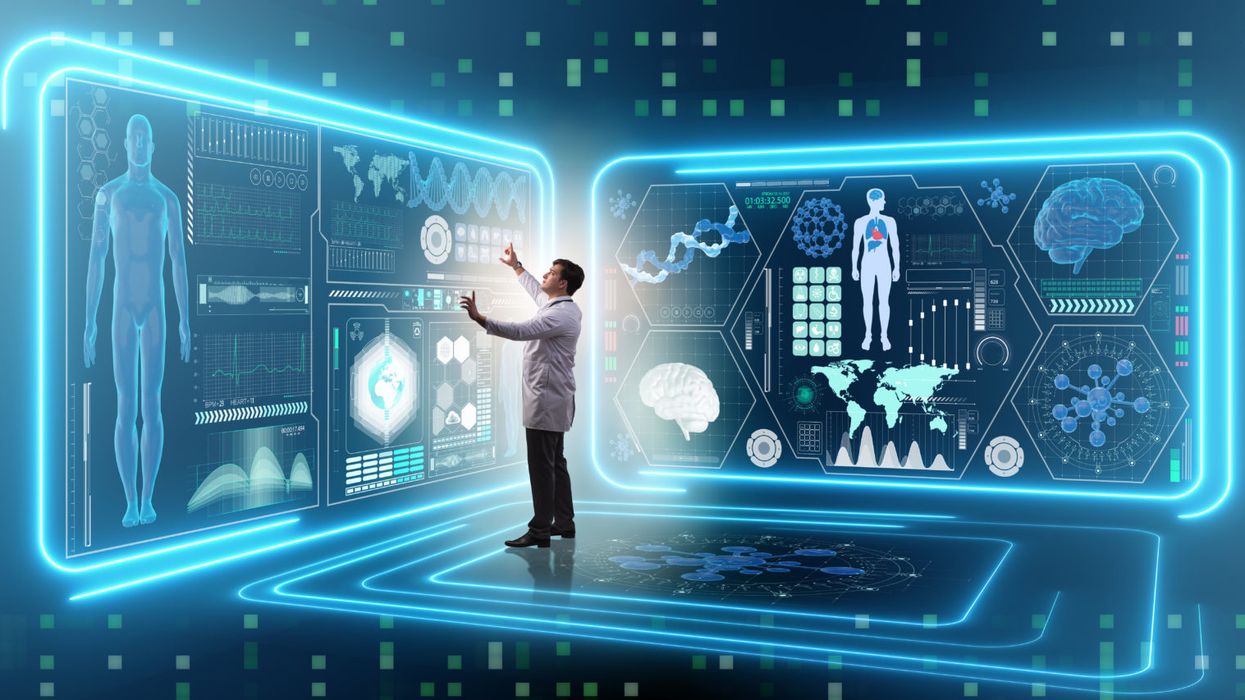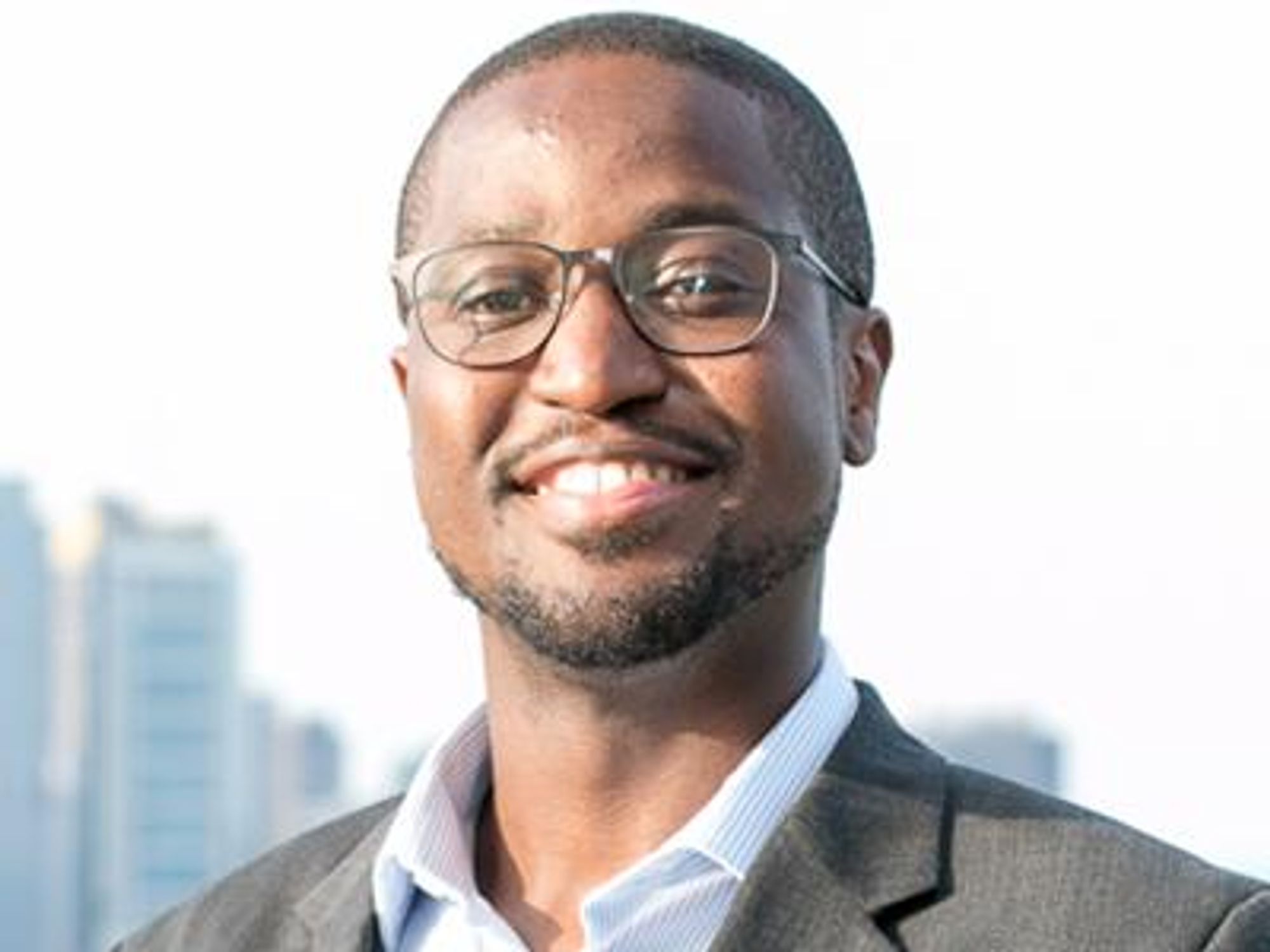“Coming Back from the Dead” Is No Longer Science Fiction

A man receiving cardiopulmonary resuscitation (CPR).
Last year, there were widespread reports of a 53-year-old Frenchman who had suffered a cardiac arrest and "died," but was then resuscitated back to life 18 hours after his heart had stopped.
The once black-and-white line between life and death is now blurrier than ever.
This was thought to have been possible in part because his body had progressively cooled down naturally after his heart had stopped, through exposure to the outside cold. The medical team who revived him were reported as being "stupefied" that they had been able to bring him back to life, in particular since he had not even suffered brain damage.
Interestingly, this man represents one of a growing number of extraordinary cases in which people who would otherwise be declared dead have now been revived. It is a testament to the incredible impact of resuscitation science -- a science that is providing opportunities to literally reverse death, and in doing so, shedding light on the age-old question of what happens when we die.
Death: Past and Present
Throughout history, the boundary between life and death was marked by the moment a person's heart stopped, breathing ceased, and brain function shut down. A person became motionless, lifeless, and was deemed irreversibly dead. This is because once the heart stops beating, blood flow stops and oxygen is cut off from all the body's organs, including the brain. Consequently, within seconds, breathing stops and brain activity comes to a halt. Since the cessation of the heart literally occurs in a "moment," the philosophical notion of a specific point in time of "irreversible" death still pervades society today. The law, for example, relies on "time of death," which corresponds to when the heart stops beating.
The advent of cardiopulmonary resuscitation (CPR) in the 1960s was revolutionary, demonstrating that the heart could potentially be restarted after it had stopped, and what had been a clear black-and-white line was shown to be potentially reversible in some people. What was once called death—the ultimate end point— was now widely called cardiac arrest, and became a starting point.
From then on, it was only if somebody had requested not to be resuscitated or when CPR was deemed to have failed that people would be declared dead by "cardiopulmonary criteria." Biologically, cardiac arrest and death by cardiopulmonary criteria are the same process, albeit marked at different points in time depending on when a declaration of death is made.
The apparent irreversibility of death as we know it may not necessarily reflect true irretrievable cellular damage inside the body.
Clearly, contrary to many people's perceptions, cardiac arrest is not a heart attack; it is the final step in death irrespective of cause, whether it be a stroke, a heart attack, a car accident, an overwhelming infection or cancer. This is how roughly 95 percent of the population are declared dead.
The only exception is the small proportion of people who may have suffered catastrophic brain injuries, but whose hearts can be artificially kept beating for a period of time on life-support machines. These people can be legally declared dead based on brain death criteria before their hearts have stopped. This is because the brain can die either from oxygen starvation after cardiac arrest or from massive trauma and internal bleeding. Either way, the brain dies hours or possibly longer after these injuries have taken place and not just minutes.
A Profound Realization
What has become increasingly clear is that the apparent irreversibility of death as we know it may not necessarily reflect true irretrievable cellular damage inside the body. This is consistent with a mounting understanding: it is only after a person actually dies that the cells in the body start to undergo their own process of death. Intriguingly, this process is something that can now be manipulated through medical intervention. Being cold is one of the factors that slows down the rate of cellular decay. The 53-year-old Frenchman's case and the other recent cases of resuscitation after prolonged periods of time illustrate this new understanding.
Last week's earth-shattering announcement by neuroscientist Dr. Nenad Sestan and his team out of Yale, published in the prestigious scientific journal Nature, provides further evidence that a time gap exists between actual death and cellular death in cadavers. In this seminal study, these researchers were able to restore partial function in pig brains four hours after their heads were severed from their bodies. These results follow from the pioneering work in 2001 of geneticist Fred Gage and colleagues from the Salk Institute, also published in Nature, which demonstrated the possibility of growing human brain cells in the laboratory by taking brain biopsies from cadavers in the mortuary up to 21 hours post-mortem.
The once black-and-white line between life and death is now blurrier than ever. Some people may argue this means these humans and pigs weren't truly "dead." However, that is like saying the people who were guillotined during the French Revolution were also not dead. Clearly, that is not the case. They were all dead. The problem is not death; it's our reliance on an outdated philosophical, rather than biological, notion of death.
Death can no longer be considered an absolute moment but rather a process that can be reversed even many hours after it has taken place.
But the distinction between irreversibility from a medical perspective and biological irreversibility may not matter much from a pragmatic perspective today. If medical interventions do not exist at any given time or place, then of course death cannot be reversed.
However, it is crucial to distinguish between biologically and medically: When "irreversible" loss of function arises due to inadequate treatment, then a person could be potentially brought back in the future when an alternative therapy becomes available, or even today if he or she dies in a location where novel treatments can slow down the rate of cell death. However, when true irreversible loss of function arises from a biological perspective, then no treatment will ever be able to reverse the process, whether today, tomorrow, or in a hundred years.
Probing the "Grey Zone"
Today, thanks to modern resuscitation science, death can no longer be considered an absolute moment but rather a process that can be reversed even many hours after it has taken place. How many hours? We don't really know.
One of the wider implications of our medical advances is that we can now study what happens to the human mind and consciousness after people enter the "grey zone," which marks the time after the heart stops, but before irreversible and irretrievable cell damage occurs, and people are then brought back to life. Millions have been successfully revived and many have reported experiencing a unique, universal, and transformative mental state.
Were they "dead"? Yes, according to all the criteria we have ever used. But they were able to be brought back before their "dead" bodies had reached the point of permanent, irreversible cellular damage. This reflects the period of death for all of us. So rather than a "near-death experience," I prefer a new terminology to describe these cases -- "an actual-death experience." These survivors' unique experiences are providing eyewitness testimonies of what we will all be likely to experience when we die.
Such an experience reportedly includes seeing a warm light, the presence of a compassionate perfect individual, deceased relatives, a review of their lives, a judgment of their actions and intentions as they pertain to their humanity, and in some cases a sensation of seeing doctors and nurses working to resuscitate them.
Are these experiences compatible with hallucinations or illusions? No -- in part, because these people have described real, verifiable events, which, by definition are not hallucinations, and in part, because their experiences are not compatible with confused and delirious memories that characterize oxygen deprivation.
The challenge for us scientifically is understanding how this is possible at a time when all our science tells us the brain shuts down.
For instance, it is hard to classify a structured meaningful review of one's life and one's humanity as hallucinatory or illusory. Instead, these experiences represent a new understanding of the overall human experience of death. As an intensive care unit physician for more than 10 years, I have seen numerous cases where these reports have been corroborated by my colleagues. In short, these survivors have been known to come back with reports of full consciousness, with lucid, well-structured thought processes and memory formation.
The challenge for us scientifically is understanding how this is possible at a time when all our science tells us the brain shuts down. The fact that these experiences occur is a paradox and suggests the undiscovered entity we call the "self," "consciousness," or "psyche" – the thing that makes us who we are - may not become annihilated at the point of so-called death.
At New York University, the State University of New York, and across 20 hospitals in the U.S. and Europe, we have brought together a new multi-disciplinary team of experts across many specialties, including neurology, cardiology, and intensive care. Together, we hope to improve cardiac arrest prevention and treatment, as well as to address the impact of new scientific discoveries on our understanding of what happens at death.
One of our first studies, Awareness during Resuscitation (AWARE), published in the medical journal Resuscitation in 2014, confirmed that some cardiac arrest patients report a perception of awareness without recall; others report detailed memories and experiences; and a few report full auditory and visual awareness and consciousness of their experience, from a time when brain function would be expected to have ceased.
While you probably have some opinion or belief about this based upon your own philosophical, religious, or cultural background, you may not realize that exploring what happens when we die is now a subject that science is beginning to investigate.
There is no question more intriguing to humankind. And for the first time in our history, we may finally uncover some real answers.
Why you should (virtually) care
Virtual-first care, or V1C, could increase the quality of healthcare and make it more patient-centric by letting patients combine in-person visits with virtual options such as video for seeing their care providers.
As the pandemic turns endemic, healthcare providers have been eagerly urging patients to return to their offices to enjoy the benefits of in-person care.
But wait.
The last two years have forced all sorts of organizations to be nimble, adaptable and creative in how they work, and this includes healthcare providers’ efforts to maintain continuity of care under the most challenging of conditions. So before we go back to “business as usual,” don’t we owe it to those providers and ourselves to admit that business as usual did not work for most of the people the industry exists to help? If we’re going to embrace yet another period of change – periods that don’t happen often in our complex industry – shouldn’t we first stop and ask ourselves what we’re trying to achieve?
Certainly, COVID has shown that telehealth can be an invaluable tool, particularly for patients in rural and underserved communities that lack access to specialty care. It’s also become clear that many – though not all – healthcare encounters can be effectively conducted from afar. That said, the telehealth tactics that filled the gap during the pandemic were largely stitched together substitutes for existing visit-based workflows: with offices closed, patients scheduled video visits for help managing the side effects of their blood pressure medications or to see their endocrinologist for a quarterly check-in. Anyone whose children slogged through the last year or two of remote learning can tell you that simply virtualizing existing processes doesn’t necessarily improve the experience or the outcomes!
But what if our approach to post-pandemic healthcare came from a patient-driven perspective? We have a fleeting opportunity to advance a care model centered on convenient and equitable access that first prioritizes good outcomes, then selects approaches to care – and locations – tailored to each patient. Using the example of education, imagine how effective it would be if each student, regardless of their school district and aptitude, received such individualized attention.
That’s the idea behind virtual-first care (V1C), a new care model centered on convenient, customized, high-quality care that integrates a full suite of services tailored directly to patients’ clinical needs and preferences. This package includes asynchronous communication such as texting; video and other live virtual modes; and in-person options.
V1C goes beyond what you might think of as standard “telehealth” by using evidence-based protocols and tools that include traditional and digital therapeutics and testing, personalized care plans, dynamic patient monitoring, and team-based approaches to care. This could include spit kits mailed for laboratory tests and complementing clinical care with health coaching. V1C also replaces some in-person exams with ongoing monitoring, using sensors for more ‘whole person’ care.
Amidst all this momentum, we have the opportunity to rethink the goals of healthcare innovation, but that means bringing together key stakeholders to demonstrate that sustainable V1C can redefine healthcare.
Established V1C healthcare providers such as Omada, Headspace, and Heartbeat Health, as well as emerging market entrants like Oshi, Visana, and Wellinks, work with a variety of patients who have complicated long-term conditions such as diabetes, heart failure, gastrointestinal illness, endometriosis, and COPD. V1C is comprehensive in ways that are lacking in digital health and its other predecessors: it has the potential to integrate multiple data streams, incorporate more frequent touches and check-ins over time, and manage a much wider range of chronic health conditions, improving lives and reducing disease burden now and in the future.
Recognizing the pandemic-driven interest in virtual care, significant energy and resources are already flowing fast toward V1C. Some of the world’s largest innovators jumped into V1C early on: Verily, Alphabet’s Life Sciences Company, launched Onduo in 2016 to disrupt the diabetes healthcare market, and is now well positioned to scale its solutions. Major insurers like Aetna and United now offer virtual-first plans to members, responding as organizations expand virtual options for employees. Amidst all this momentum, we have the opportunity to rethink the goals of healthcare innovation, but that means bringing together key stakeholders to demonstrate that sustainable V1C can redefine healthcare.
That was the immediate impetus for IMPACT, a consortium of V1C companies, investors, payers and patients founded last year to ensure access to high-quality, evidence-based V1C. Developed by our team at the Digital Medicine Society (DiMe) in collaboration with the American Telemedicine Association (ATA), IMPACT has begun to explore key issues that include giving patients more integrated experiences when accessing both virtual and brick-and-mortar care.

Digital Medicine Society
V1C is not, nor should it be, virtual-only care. In this new era of hybrid healthcare, success will be defined by how well providers help patients navigate the transitions. How do we smoothly hand a patient off from an onsite primary care physician to, say, a virtual cardiologist? How do we get information from a brick-and-mortar to a digital portal? How do you manage dataflow while still staying HIPAA compliant? There are many complex regulatory implications for these new models, as well as an evolving landscape in terms of privacy, security and interoperability. It will be no small task for groups like IMPACT to determine the best path forward.
None of these factors matter unless the industry can recruit and retain clinicians. Our field is facing an unprecedented workforce crisis. Traditional healthcare is making clinicians miserable, and COVID has only accelerated the trend of overworked, disenchanted healthcare workers leaving in droves. Clinicians want more interactions with patients, and fewer with computer screens – call it “More face time, less FaceTime.” No new model will succeed unless the industry can more efficiently deploy its talent – arguably its most scarce and precious resource. V1C can help with alleviating the increasing burden and frustration borne by individual physicians in today’s status quo.
In healthcare, new technological approaches inevitably provoke no shortage of skepticism. Past lessons from Silicon Valley-driven fixes have led to understandable cynicism. But V1C is a different breed of animal. By building healthcare around the patient, not the clinic, V1C can make healthcare work better for patients, payers and providers. We’re at a fork in the road: we can revert back to a broken sick-care system, or dig in and do the hard work of figuring out how this future-forward healthcare system gets financed, organized and executed. As a field, we must find the courage and summon the energy to embrace this moment, and make it a moment of change.
Podcast: The future of brain health with Percy Griffin
Percy Griffin, director of scientific engagement for the Alzheimer’s Association, joins Leaps.org to discuss the present and future of the fight against dementia.
Today's guest is Percy Griffin, director of scientific engagement for the Alzheimer’s Association, a nonprofit that’s focused on speeding up research, finding better ways to detect Alzheimer’s earlier and other approaches for reducing risk. Percy has a doctorate in molecular cell biology from Washington University, he’s led important research on Alzheimer’s, and you can find the link to his full bio in the show notes, below.
Our topic for this conversation is the present and future of the fight against dementia. Billions of dollars have been spent by the National Institutes of Health and biotechs to research new treatments for Alzheimer's and other forms of dementia, but so far there's been little to show for it. Last year, Aduhelm became the first drug to be approved by the FDA for Alzheimer’s in 20 years, but it's received a raft of bad publicity, with red flags about its effectiveness, side effects and cost.
Meanwhile, 6.5 million Americans have Alzheimer's, and this number could increase to 13 million in 2050. Listen to this conversation if you’re concerned about your own brain health, that of family members getting older, or if you’re just concerned about the future of this country with experts predicting the number people over 65 will increase dramatically in the very near future.
Listen to the Episode
Listen on Apple | Listen on Spotify | Listen on Stitcher | Listen on Amazon | Listen on Google
4:40 - We talk about the parts of Percy’s life that led to him to concentrate on working in this important area.
6:20 - He defines Alzheimer's and dementia, and discusses the key elements of communicating science.
10:20 - Percy explains why the Alzheimer’s Association has been supportive of Aduhelm, even as others have been critical.
17:58 - We talk about therapeutics under development, which ones to be excited about, and how they could be tailored to a person's own biology.
24:25 - Percy discusses funding and tradeoffs between investing more money into Alzheimer’s research compared to other intractable diseases like cancer, and new opportunities to accelerate progress, such as ARPA-H, President Biden’s proposed agency to speed up health breakthroughs.
27:24 - We talk about the social determinants of brain health. What are the pros/cons of continuing to spend massive sums of money to develop new drugs like Aduhelm versus refocusing on expanding policies to address social determinants - like better education, nutritious food and safe drinking water - that have enabled some groups more than others to enjoy improved cognition late in life.
34:18 - Percy describes his top lifestyle recommendations for protecting your mind.
37:33 - Is napping bad for the brain?
39:39 - Circadian rhythm and Alzheimer's.
42:34 - What tests can people take to check their brain health today, and which biomarkers are we making progress on?
47:25 - Percy highlights important programs run by the Alzheimer’s Association to support advances.
Show links:
** After this episode was recorded, the Centers for Medicare and Medicaid Services affirmed its decision from last June to limit coverage of Aduhelm. More here.
- Percy Griffin's bio: https://www.alz.org/manh/events/alztalks/upcoming-...
- The Alzheimer's Association's Part the Cloud program: https://alz.org/partthecloud/about-us.asp
- The paradox of dementia rates decreasing: https://www.ncbi.nlm.nih.gov/pmc/articles/PMC7455342/
- The argument for focusing more resources on improving institutions and social processes for brain health: https://www.statnews.com/2021/09/23/the-brain-heal...
- Recent research on napping: https://www.ocregister.com/2022/03/25/alzheimers-s...
- The Alzheimer's Association helpline: https://www.alz.org/help-support/resources/helpline
- ALZConnected, a free online community for people affected by dementia https://www.alzconnected.org/
- TrialMatch for people with dementia and healthy volunteers to find clinical trials for Alzheimer's and other dementia: https://www.alz.org/alzheimers-dementia/research_p...

